Fair Value Accounting: Essay and Case Study of ASX Listed Companies
VerifiedAdded on 2023/06/04
|7
|2656
|458
Report
AI Summary
This report, prepared as a group assignment for ACC202, delves into the relevance of fair value accounting. It begins with an essay exploring the concept's advantages and disadvantages, referencing the arguments of Laux and Leuz (2009) and Whittington (2008). The essay examines the applicability of fair value accounting to long-term assets, market volatility, and its impact on financial statements and investor behavior, as well as its limitations compared to historical cost accounting. The second part is a case study comparing fair value classification by Westpac Banking Corporation and BHP Billiton Limited. The analysis highlights the differences in fair value accounting practices between the two companies, considering their respective industry sectors and the principles of income and asset valuation. Both companies use fair value to gain a clear understanding of their financial positions in the market, although the specific application varies depending on the nature of their assets and business activities.
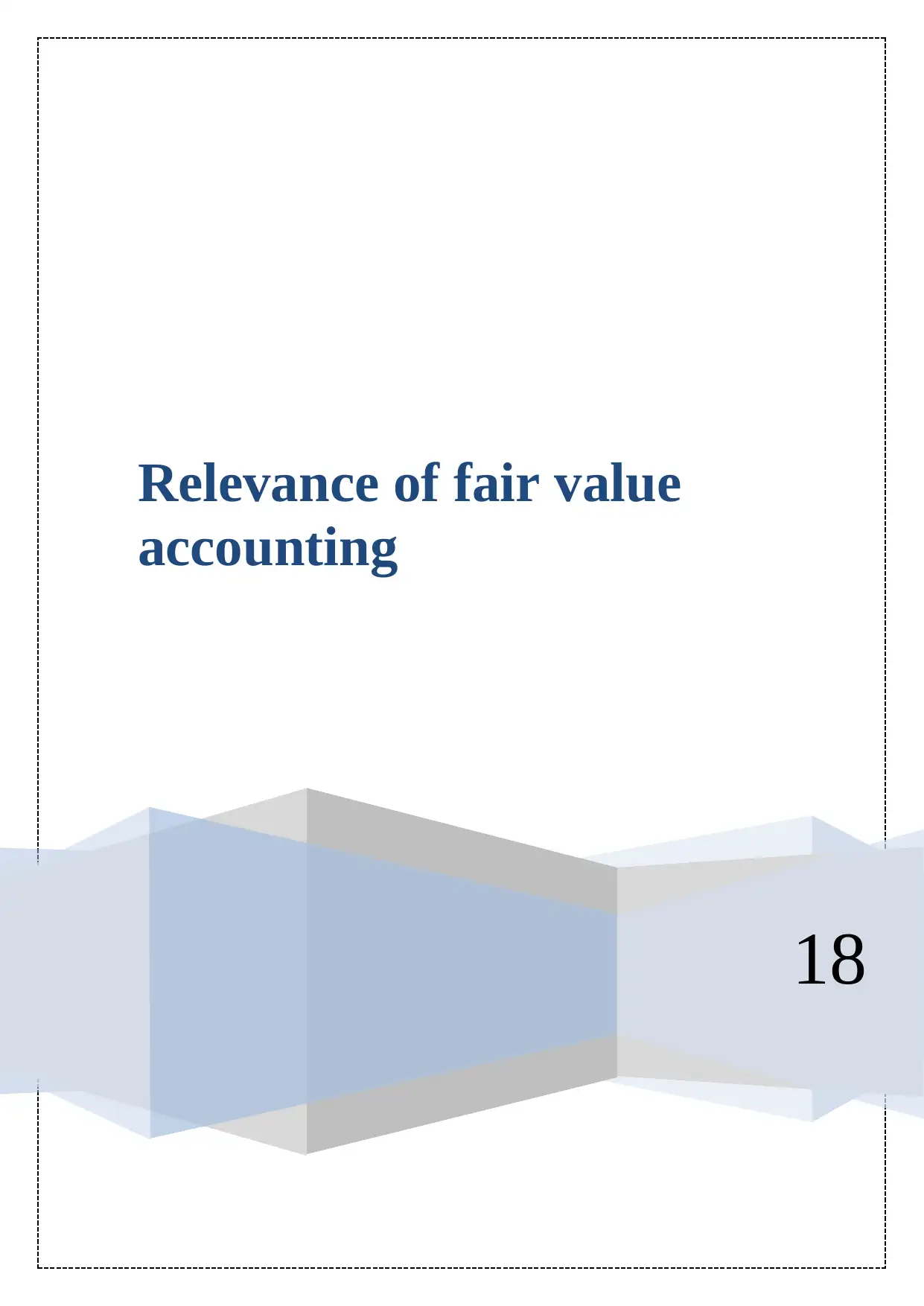
18
Relevance of fair value
accounting
Relevance of fair value
accounting
Paraphrase This Document
Need a fresh take? Get an instant paraphrase of this document with our AI Paraphraser
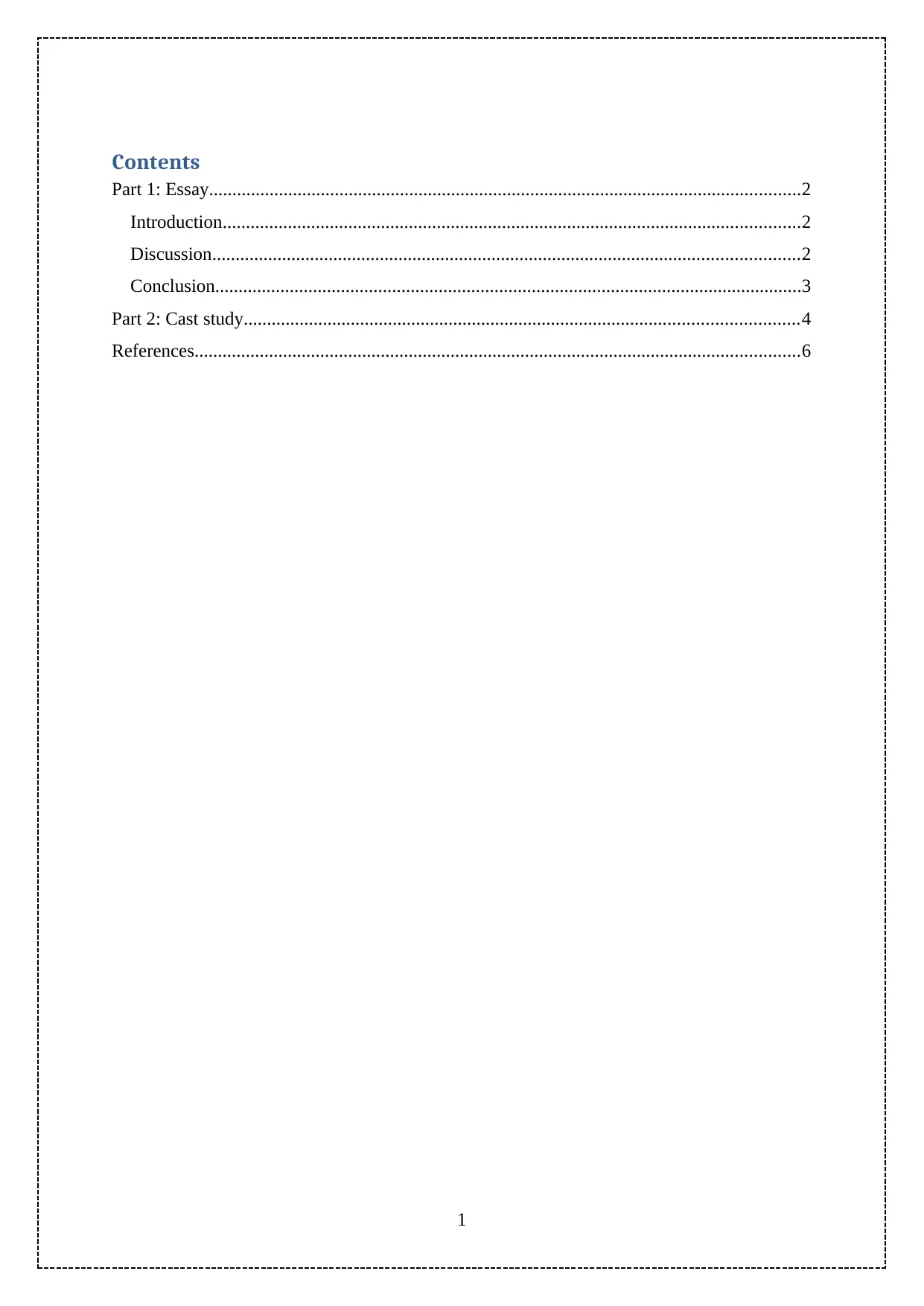
Contents
Part 1: Essay...............................................................................................................................2
Introduction............................................................................................................................2
Discussion..............................................................................................................................2
Conclusion..............................................................................................................................3
Part 2: Cast study.......................................................................................................................4
References..................................................................................................................................6
1
Part 1: Essay...............................................................................................................................2
Introduction............................................................................................................................2
Discussion..............................................................................................................................2
Conclusion..............................................................................................................................3
Part 2: Cast study.......................................................................................................................4
References..................................................................................................................................6
1
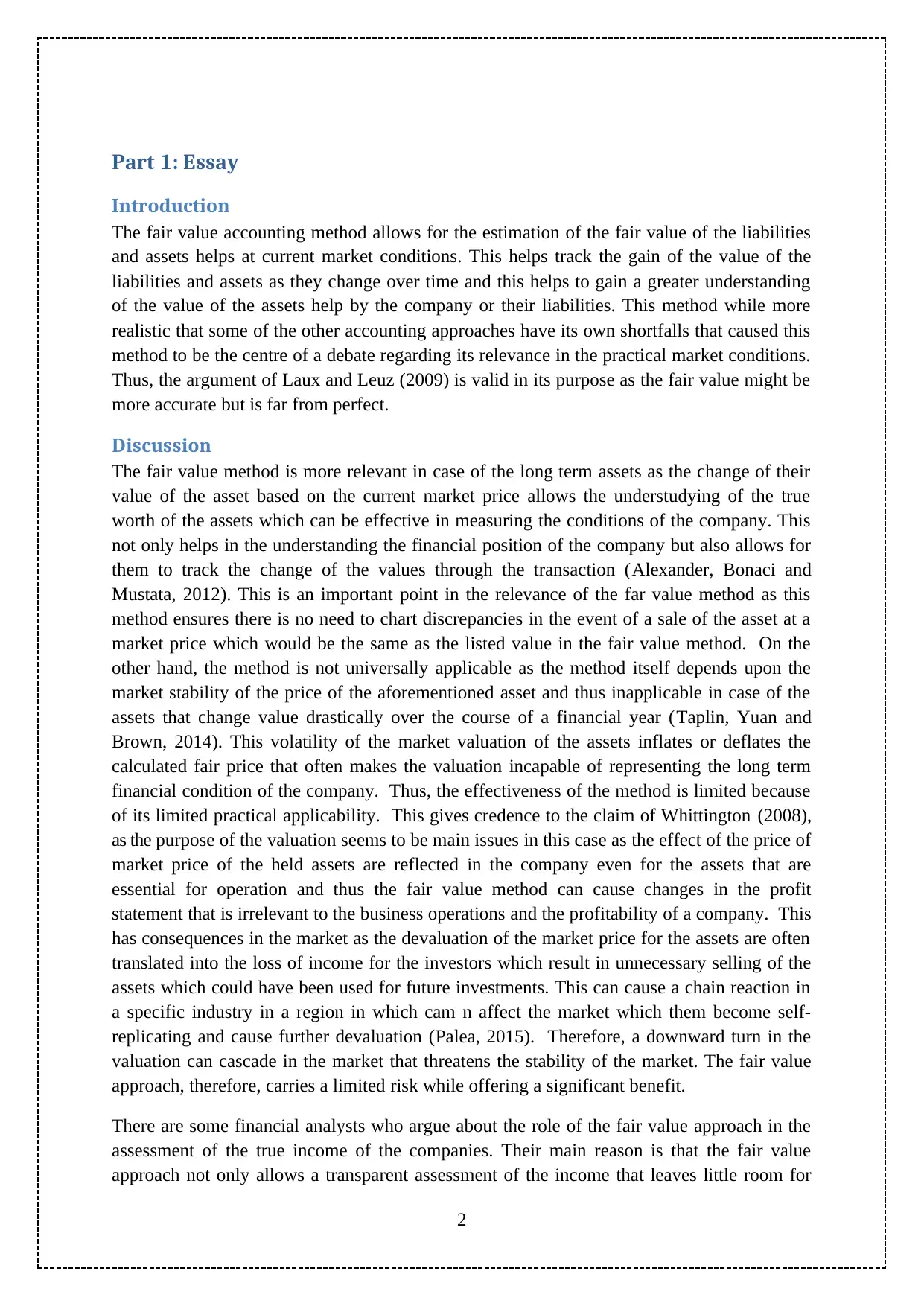
Part 1: Essay
Introduction
The fair value accounting method allows for the estimation of the fair value of the liabilities
and assets helps at current market conditions. This helps track the gain of the value of the
liabilities and assets as they change over time and this helps to gain a greater understanding
of the value of the assets help by the company or their liabilities. This method while more
realistic that some of the other accounting approaches have its own shortfalls that caused this
method to be the centre of a debate regarding its relevance in the practical market conditions.
Thus, the argument of Laux and Leuz (2009) is valid in its purpose as the fair value might be
more accurate but is far from perfect.
Discussion
The fair value method is more relevant in case of the long term assets as the change of their
value of the asset based on the current market price allows the understudying of the true
worth of the assets which can be effective in measuring the conditions of the company. This
not only helps in the understanding the financial position of the company but also allows for
them to track the change of the values through the transaction (Alexander, Bonaci and
Mustata, 2012). This is an important point in the relevance of the far value method as this
method ensures there is no need to chart discrepancies in the event of a sale of the asset at a
market price which would be the same as the listed value in the fair value method. On the
other hand, the method is not universally applicable as the method itself depends upon the
market stability of the price of the aforementioned asset and thus inapplicable in case of the
assets that change value drastically over the course of a financial year (Taplin, Yuan and
Brown, 2014). This volatility of the market valuation of the assets inflates or deflates the
calculated fair price that often makes the valuation incapable of representing the long term
financial condition of the company. Thus, the effectiveness of the method is limited because
of its limited practical applicability. This gives credence to the claim of Whittington (2008),
as the purpose of the valuation seems to be main issues in this case as the effect of the price of
market price of the held assets are reflected in the company even for the assets that are
essential for operation and thus the fair value method can cause changes in the profit
statement that is irrelevant to the business operations and the profitability of a company. This
has consequences in the market as the devaluation of the market price for the assets are often
translated into the loss of income for the investors which result in unnecessary selling of the
assets which could have been used for future investments. This can cause a chain reaction in
a specific industry in a region in which cam n affect the market which them become self-
replicating and cause further devaluation (Palea, 2015). Therefore, a downward turn in the
valuation can cascade in the market that threatens the stability of the market. The fair value
approach, therefore, carries a limited risk while offering a significant benefit.
There are some financial analysts who argue about the role of the fair value approach in the
assessment of the true income of the companies. Their main reason is that the fair value
approach not only allows a transparent assessment of the income that leaves little room for
2
Introduction
The fair value accounting method allows for the estimation of the fair value of the liabilities
and assets helps at current market conditions. This helps track the gain of the value of the
liabilities and assets as they change over time and this helps to gain a greater understanding
of the value of the assets help by the company or their liabilities. This method while more
realistic that some of the other accounting approaches have its own shortfalls that caused this
method to be the centre of a debate regarding its relevance in the practical market conditions.
Thus, the argument of Laux and Leuz (2009) is valid in its purpose as the fair value might be
more accurate but is far from perfect.
Discussion
The fair value method is more relevant in case of the long term assets as the change of their
value of the asset based on the current market price allows the understudying of the true
worth of the assets which can be effective in measuring the conditions of the company. This
not only helps in the understanding the financial position of the company but also allows for
them to track the change of the values through the transaction (Alexander, Bonaci and
Mustata, 2012). This is an important point in the relevance of the far value method as this
method ensures there is no need to chart discrepancies in the event of a sale of the asset at a
market price which would be the same as the listed value in the fair value method. On the
other hand, the method is not universally applicable as the method itself depends upon the
market stability of the price of the aforementioned asset and thus inapplicable in case of the
assets that change value drastically over the course of a financial year (Taplin, Yuan and
Brown, 2014). This volatility of the market valuation of the assets inflates or deflates the
calculated fair price that often makes the valuation incapable of representing the long term
financial condition of the company. Thus, the effectiveness of the method is limited because
of its limited practical applicability. This gives credence to the claim of Whittington (2008),
as the purpose of the valuation seems to be main issues in this case as the effect of the price of
market price of the held assets are reflected in the company even for the assets that are
essential for operation and thus the fair value method can cause changes in the profit
statement that is irrelevant to the business operations and the profitability of a company. This
has consequences in the market as the devaluation of the market price for the assets are often
translated into the loss of income for the investors which result in unnecessary selling of the
assets which could have been used for future investments. This can cause a chain reaction in
a specific industry in a region in which cam n affect the market which them become self-
replicating and cause further devaluation (Palea, 2015). Therefore, a downward turn in the
valuation can cascade in the market that threatens the stability of the market. The fair value
approach, therefore, carries a limited risk while offering a significant benefit.
There are some financial analysts who argue about the role of the fair value approach in the
assessment of the true income of the companies. Their main reason is that the fair value
approach not only allows a transparent assessment of the income that leaves little room for
2
⊘ This is a preview!⊘
Do you want full access?
Subscribe today to unlock all pages.

Trusted by 1+ million students worldwide
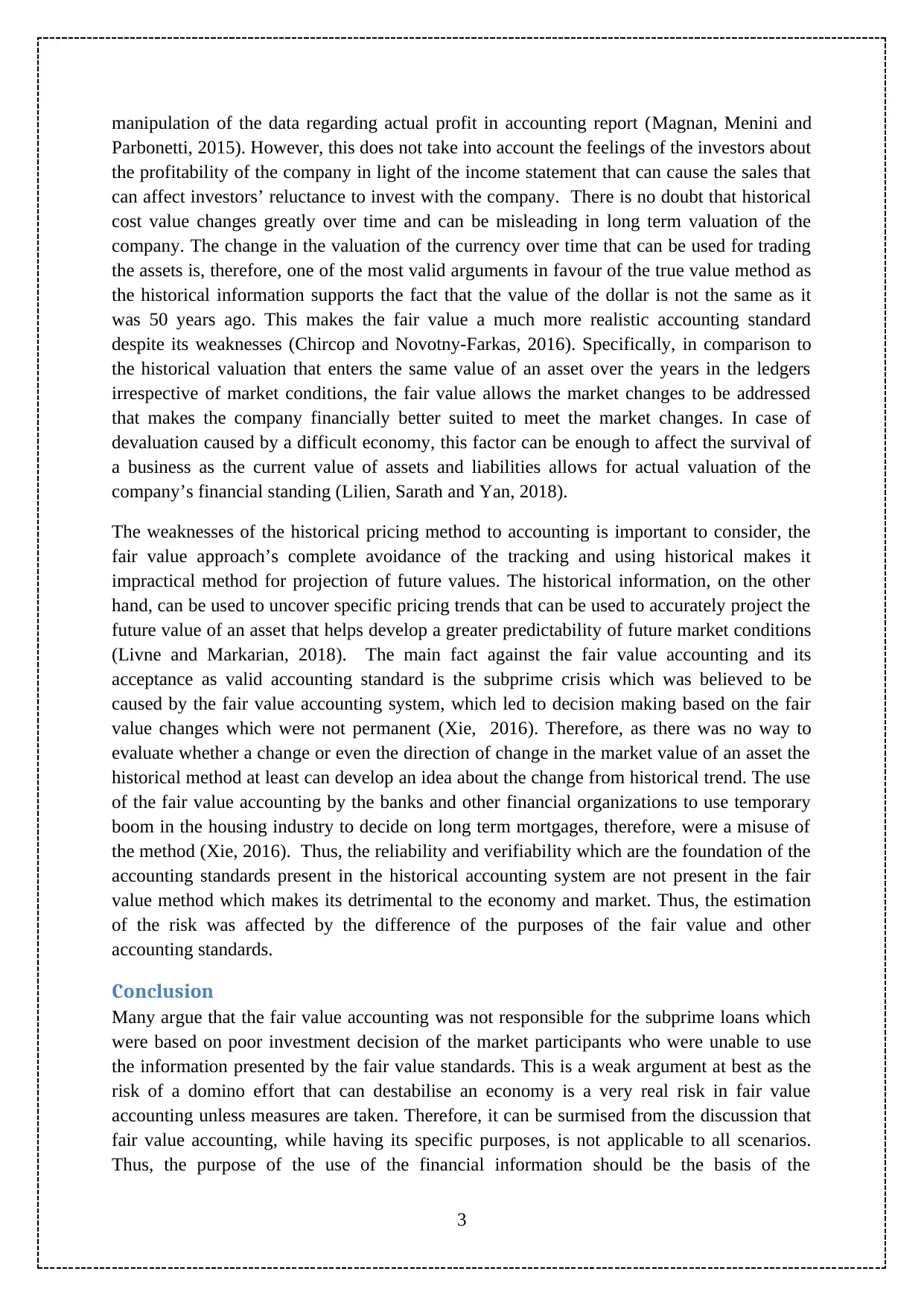
manipulation of the data regarding actual profit in accounting report (Magnan, Menini and
Parbonetti, 2015). However, this does not take into account the feelings of the investors about
the profitability of the company in light of the income statement that can cause the sales that
can affect investors’ reluctance to invest with the company. There is no doubt that historical
cost value changes greatly over time and can be misleading in long term valuation of the
company. The change in the valuation of the currency over time that can be used for trading
the assets is, therefore, one of the most valid arguments in favour of the true value method as
the historical information supports the fact that the value of the dollar is not the same as it
was 50 years ago. This makes the fair value a much more realistic accounting standard
despite its weaknesses (Chircop and Novotny-Farkas, 2016). Specifically, in comparison to
the historical valuation that enters the same value of an asset over the years in the ledgers
irrespective of market conditions, the fair value allows the market changes to be addressed
that makes the company financially better suited to meet the market changes. In case of
devaluation caused by a difficult economy, this factor can be enough to affect the survival of
a business as the current value of assets and liabilities allows for actual valuation of the
company’s financial standing (Lilien, Sarath and Yan, 2018).
The weaknesses of the historical pricing method to accounting is important to consider, the
fair value approach’s complete avoidance of the tracking and using historical makes it
impractical method for projection of future values. The historical information, on the other
hand, can be used to uncover specific pricing trends that can be used to accurately project the
future value of an asset that helps develop a greater predictability of future market conditions
(Livne and Markarian, 2018). The main fact against the fair value accounting and its
acceptance as valid accounting standard is the subprime crisis which was believed to be
caused by the fair value accounting system, which led to decision making based on the fair
value changes which were not permanent (Xie, 2016). Therefore, as there was no way to
evaluate whether a change or even the direction of change in the market value of an asset the
historical method at least can develop an idea about the change from historical trend. The use
of the fair value accounting by the banks and other financial organizations to use temporary
boom in the housing industry to decide on long term mortgages, therefore, were a misuse of
the method (Xie, 2016). Thus, the reliability and verifiability which are the foundation of the
accounting standards present in the historical accounting system are not present in the fair
value method which makes its detrimental to the economy and market. Thus, the estimation
of the risk was affected by the difference of the purposes of the fair value and other
accounting standards.
Conclusion
Many argue that the fair value accounting was not responsible for the subprime loans which
were based on poor investment decision of the market participants who were unable to use
the information presented by the fair value standards. This is a weak argument at best as the
risk of a domino effort that can destabilise an economy is a very real risk in fair value
accounting unless measures are taken. Therefore, it can be surmised from the discussion that
fair value accounting, while having its specific purposes, is not applicable to all scenarios.
Thus, the purpose of the use of the financial information should be the basis of the
3
Parbonetti, 2015). However, this does not take into account the feelings of the investors about
the profitability of the company in light of the income statement that can cause the sales that
can affect investors’ reluctance to invest with the company. There is no doubt that historical
cost value changes greatly over time and can be misleading in long term valuation of the
company. The change in the valuation of the currency over time that can be used for trading
the assets is, therefore, one of the most valid arguments in favour of the true value method as
the historical information supports the fact that the value of the dollar is not the same as it
was 50 years ago. This makes the fair value a much more realistic accounting standard
despite its weaknesses (Chircop and Novotny-Farkas, 2016). Specifically, in comparison to
the historical valuation that enters the same value of an asset over the years in the ledgers
irrespective of market conditions, the fair value allows the market changes to be addressed
that makes the company financially better suited to meet the market changes. In case of
devaluation caused by a difficult economy, this factor can be enough to affect the survival of
a business as the current value of assets and liabilities allows for actual valuation of the
company’s financial standing (Lilien, Sarath and Yan, 2018).
The weaknesses of the historical pricing method to accounting is important to consider, the
fair value approach’s complete avoidance of the tracking and using historical makes it
impractical method for projection of future values. The historical information, on the other
hand, can be used to uncover specific pricing trends that can be used to accurately project the
future value of an asset that helps develop a greater predictability of future market conditions
(Livne and Markarian, 2018). The main fact against the fair value accounting and its
acceptance as valid accounting standard is the subprime crisis which was believed to be
caused by the fair value accounting system, which led to decision making based on the fair
value changes which were not permanent (Xie, 2016). Therefore, as there was no way to
evaluate whether a change or even the direction of change in the market value of an asset the
historical method at least can develop an idea about the change from historical trend. The use
of the fair value accounting by the banks and other financial organizations to use temporary
boom in the housing industry to decide on long term mortgages, therefore, were a misuse of
the method (Xie, 2016). Thus, the reliability and verifiability which are the foundation of the
accounting standards present in the historical accounting system are not present in the fair
value method which makes its detrimental to the economy and market. Thus, the estimation
of the risk was affected by the difference of the purposes of the fair value and other
accounting standards.
Conclusion
Many argue that the fair value accounting was not responsible for the subprime loans which
were based on poor investment decision of the market participants who were unable to use
the information presented by the fair value standards. This is a weak argument at best as the
risk of a domino effort that can destabilise an economy is a very real risk in fair value
accounting unless measures are taken. Therefore, it can be surmised from the discussion that
fair value accounting, while having its specific purposes, is not applicable to all scenarios.
Thus, the purpose of the use of the financial information should be the basis of the
3
Paraphrase This Document
Need a fresh take? Get an instant paraphrase of this document with our AI Paraphraser
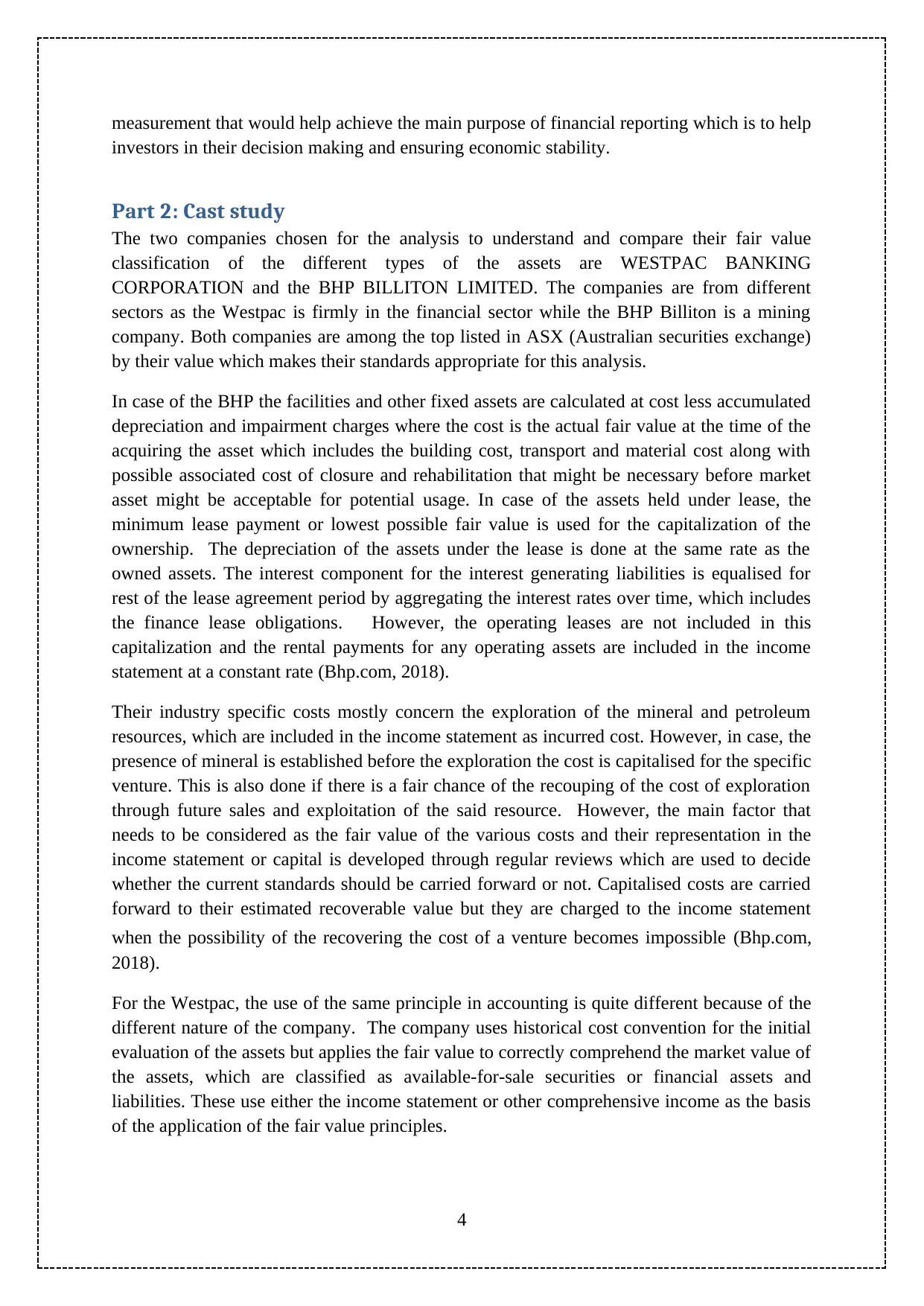
measurement that would help achieve the main purpose of financial reporting which is to help
investors in their decision making and ensuring economic stability.
Part 2: Cast study
The two companies chosen for the analysis to understand and compare their fair value
classification of the different types of the assets are WESTPAC BANKING
CORPORATION and the BHP BILLITON LIMITED. The companies are from different
sectors as the Westpac is firmly in the financial sector while the BHP Billiton is a mining
company. Both companies are among the top listed in ASX (Australian securities exchange)
by their value which makes their standards appropriate for this analysis.
In case of the BHP the facilities and other fixed assets are calculated at cost less accumulated
depreciation and impairment charges where the cost is the actual fair value at the time of the
acquiring the asset which includes the building cost, transport and material cost along with
possible associated cost of closure and rehabilitation that might be necessary before market
asset might be acceptable for potential usage. In case of the assets held under lease, the
minimum lease payment or lowest possible fair value is used for the capitalization of the
ownership. The depreciation of the assets under the lease is done at the same rate as the
owned assets. The interest component for the interest generating liabilities is equalised for
rest of the lease agreement period by aggregating the interest rates over time, which includes
the finance lease obligations. However, the operating leases are not included in this
capitalization and the rental payments for any operating assets are included in the income
statement at a constant rate (Bhp.com, 2018).
Their industry specific costs mostly concern the exploration of the mineral and petroleum
resources, which are included in the income statement as incurred cost. However, in case, the
presence of mineral is established before the exploration the cost is capitalised for the specific
venture. This is also done if there is a fair chance of the recouping of the cost of exploration
through future sales and exploitation of the said resource. However, the main factor that
needs to be considered as the fair value of the various costs and their representation in the
income statement or capital is developed through regular reviews which are used to decide
whether the current standards should be carried forward or not. Capitalised costs are carried
forward to their estimated recoverable value but they are charged to the income statement
when the possibility of the recovering the cost of a venture becomes impossible (Bhp.com,
2018).
For the Westpac, the use of the same principle in accounting is quite different because of the
different nature of the company. The company uses historical cost convention for the initial
evaluation of the assets but applies the fair value to correctly comprehend the market value of
the assets, which are classified as available-for-sale securities or financial assets and
liabilities. These use either the income statement or other comprehensive income as the basis
of the application of the fair value principles.
4
investors in their decision making and ensuring economic stability.
Part 2: Cast study
The two companies chosen for the analysis to understand and compare their fair value
classification of the different types of the assets are WESTPAC BANKING
CORPORATION and the BHP BILLITON LIMITED. The companies are from different
sectors as the Westpac is firmly in the financial sector while the BHP Billiton is a mining
company. Both companies are among the top listed in ASX (Australian securities exchange)
by their value which makes their standards appropriate for this analysis.
In case of the BHP the facilities and other fixed assets are calculated at cost less accumulated
depreciation and impairment charges where the cost is the actual fair value at the time of the
acquiring the asset which includes the building cost, transport and material cost along with
possible associated cost of closure and rehabilitation that might be necessary before market
asset might be acceptable for potential usage. In case of the assets held under lease, the
minimum lease payment or lowest possible fair value is used for the capitalization of the
ownership. The depreciation of the assets under the lease is done at the same rate as the
owned assets. The interest component for the interest generating liabilities is equalised for
rest of the lease agreement period by aggregating the interest rates over time, which includes
the finance lease obligations. However, the operating leases are not included in this
capitalization and the rental payments for any operating assets are included in the income
statement at a constant rate (Bhp.com, 2018).
Their industry specific costs mostly concern the exploration of the mineral and petroleum
resources, which are included in the income statement as incurred cost. However, in case, the
presence of mineral is established before the exploration the cost is capitalised for the specific
venture. This is also done if there is a fair chance of the recouping of the cost of exploration
through future sales and exploitation of the said resource. However, the main factor that
needs to be considered as the fair value of the various costs and their representation in the
income statement or capital is developed through regular reviews which are used to decide
whether the current standards should be carried forward or not. Capitalised costs are carried
forward to their estimated recoverable value but they are charged to the income statement
when the possibility of the recovering the cost of a venture becomes impossible (Bhp.com,
2018).
For the Westpac, the use of the same principle in accounting is quite different because of the
different nature of the company. The company uses historical cost convention for the initial
evaluation of the assets but applies the fair value to correctly comprehend the market value of
the assets, which are classified as available-for-sale securities or financial assets and
liabilities. These use either the income statement or other comprehensive income as the basis
of the application of the fair value principles.
4
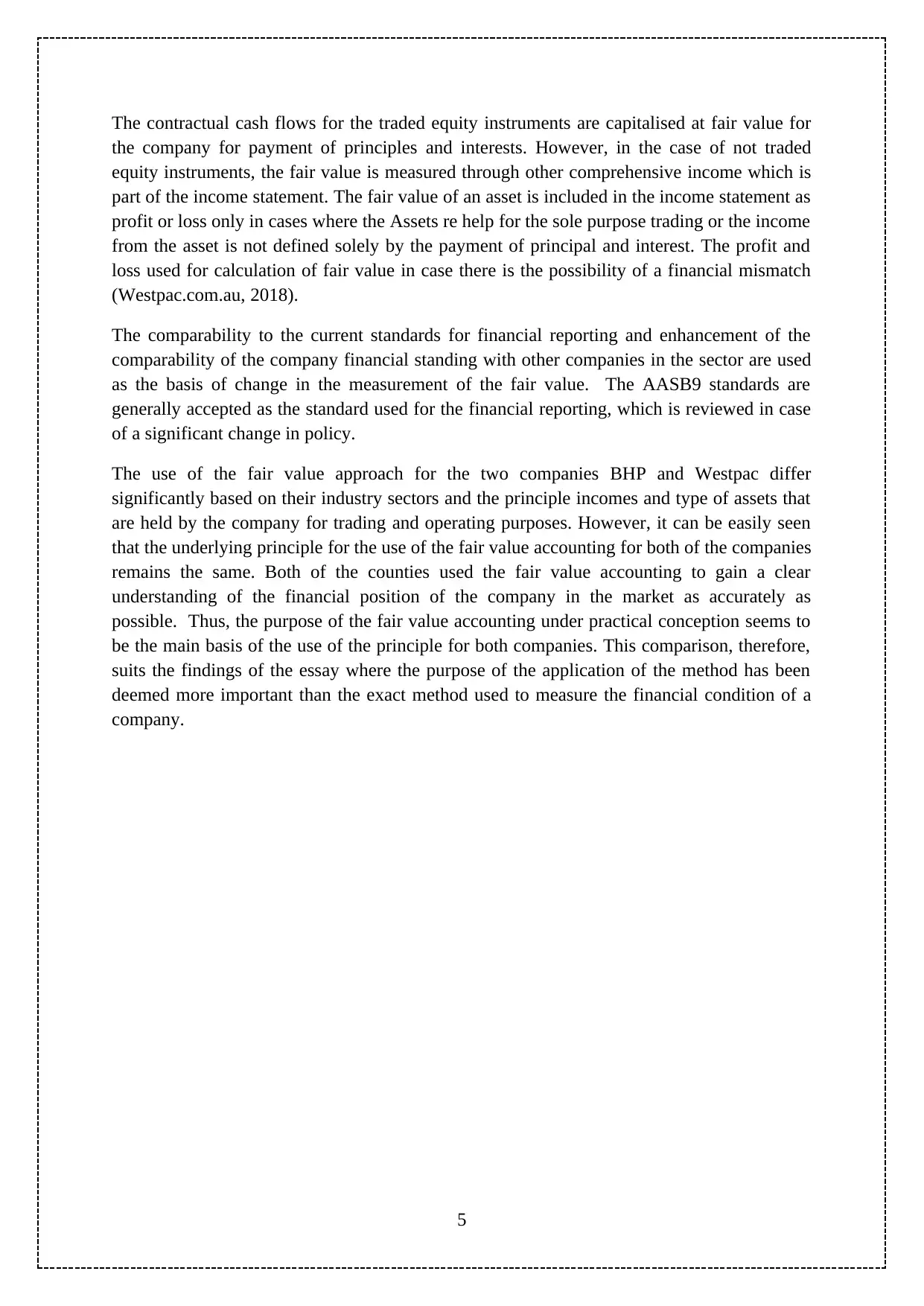
The contractual cash flows for the traded equity instruments are capitalised at fair value for
the company for payment of principles and interests. However, in the case of not traded
equity instruments, the fair value is measured through other comprehensive income which is
part of the income statement. The fair value of an asset is included in the income statement as
profit or loss only in cases where the Assets re help for the sole purpose trading or the income
from the asset is not defined solely by the payment of principal and interest. The profit and
loss used for calculation of fair value in case there is the possibility of a financial mismatch
(Westpac.com.au, 2018).
The comparability to the current standards for financial reporting and enhancement of the
comparability of the company financial standing with other companies in the sector are used
as the basis of change in the measurement of the fair value. The AASB9 standards are
generally accepted as the standard used for the financial reporting, which is reviewed in case
of a significant change in policy.
The use of the fair value approach for the two companies BHP and Westpac differ
significantly based on their industry sectors and the principle incomes and type of assets that
are held by the company for trading and operating purposes. However, it can be easily seen
that the underlying principle for the use of the fair value accounting for both of the companies
remains the same. Both of the counties used the fair value accounting to gain a clear
understanding of the financial position of the company in the market as accurately as
possible. Thus, the purpose of the fair value accounting under practical conception seems to
be the main basis of the use of the principle for both companies. This comparison, therefore,
suits the findings of the essay where the purpose of the application of the method has been
deemed more important than the exact method used to measure the financial condition of a
company.
5
the company for payment of principles and interests. However, in the case of not traded
equity instruments, the fair value is measured through other comprehensive income which is
part of the income statement. The fair value of an asset is included in the income statement as
profit or loss only in cases where the Assets re help for the sole purpose trading or the income
from the asset is not defined solely by the payment of principal and interest. The profit and
loss used for calculation of fair value in case there is the possibility of a financial mismatch
(Westpac.com.au, 2018).
The comparability to the current standards for financial reporting and enhancement of the
comparability of the company financial standing with other companies in the sector are used
as the basis of change in the measurement of the fair value. The AASB9 standards are
generally accepted as the standard used for the financial reporting, which is reviewed in case
of a significant change in policy.
The use of the fair value approach for the two companies BHP and Westpac differ
significantly based on their industry sectors and the principle incomes and type of assets that
are held by the company for trading and operating purposes. However, it can be easily seen
that the underlying principle for the use of the fair value accounting for both of the companies
remains the same. Both of the counties used the fair value accounting to gain a clear
understanding of the financial position of the company in the market as accurately as
possible. Thus, the purpose of the fair value accounting under practical conception seems to
be the main basis of the use of the principle for both companies. This comparison, therefore,
suits the findings of the essay where the purpose of the application of the method has been
deemed more important than the exact method used to measure the financial condition of a
company.
5
⊘ This is a preview!⊘
Do you want full access?
Subscribe today to unlock all pages.

Trusted by 1+ million students worldwide
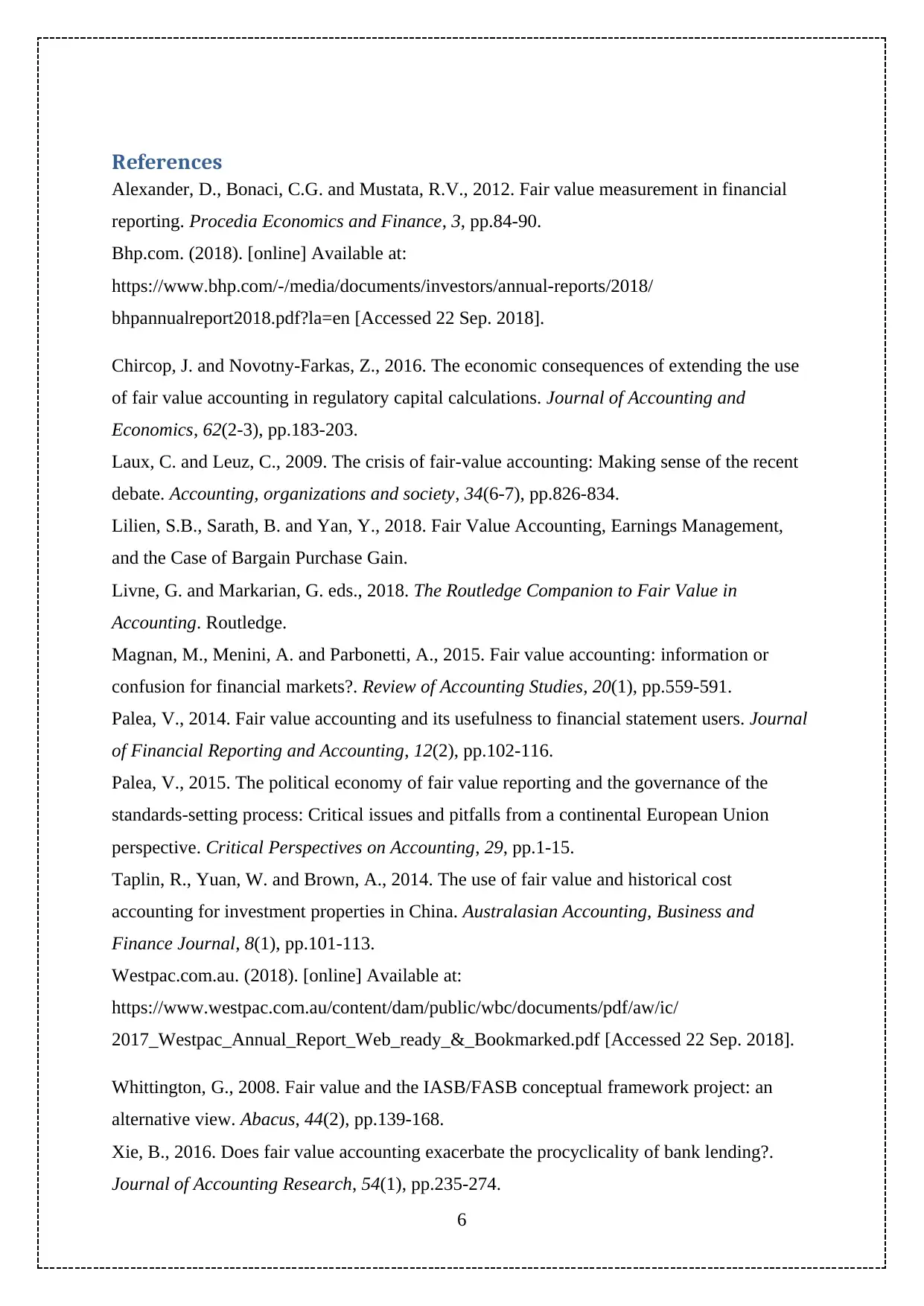
References
Alexander, D., Bonaci, C.G. and Mustata, R.V., 2012. Fair value measurement in financial
reporting. Procedia Economics and Finance, 3, pp.84-90.
Bhp.com. (2018). [online] Available at:
https://www.bhp.com/-/media/documents/investors/annual-reports/2018/
bhpannualreport2018.pdf?la=en [Accessed 22 Sep. 2018].
Chircop, J. and Novotny-Farkas, Z., 2016. The economic consequences of extending the use
of fair value accounting in regulatory capital calculations. Journal of Accounting and
Economics, 62(2-3), pp.183-203.
Laux, C. and Leuz, C., 2009. The crisis of fair-value accounting: Making sense of the recent
debate. Accounting, organizations and society, 34(6-7), pp.826-834.
Lilien, S.B., Sarath, B. and Yan, Y., 2018. Fair Value Accounting, Earnings Management,
and the Case of Bargain Purchase Gain.
Livne, G. and Markarian, G. eds., 2018. The Routledge Companion to Fair Value in
Accounting. Routledge.
Magnan, M., Menini, A. and Parbonetti, A., 2015. Fair value accounting: information or
confusion for financial markets?. Review of Accounting Studies, 20(1), pp.559-591.
Palea, V., 2014. Fair value accounting and its usefulness to financial statement users. Journal
of Financial Reporting and Accounting, 12(2), pp.102-116.
Palea, V., 2015. The political economy of fair value reporting and the governance of the
standards-setting process: Critical issues and pitfalls from a continental European Union
perspective. Critical Perspectives on Accounting, 29, pp.1-15.
Taplin, R., Yuan, W. and Brown, A., 2014. The use of fair value and historical cost
accounting for investment properties in China. Australasian Accounting, Business and
Finance Journal, 8(1), pp.101-113.
Westpac.com.au. (2018). [online] Available at:
https://www.westpac.com.au/content/dam/public/wbc/documents/pdf/aw/ic/
2017_Westpac_Annual_Report_Web_ready_&_Bookmarked.pdf [Accessed 22 Sep. 2018].
Whittington, G., 2008. Fair value and the IASB/FASB conceptual framework project: an
alternative view. Abacus, 44(2), pp.139-168.
Xie, B., 2016. Does fair value accounting exacerbate the procyclicality of bank lending?.
Journal of Accounting Research, 54(1), pp.235-274.
6
Alexander, D., Bonaci, C.G. and Mustata, R.V., 2012. Fair value measurement in financial
reporting. Procedia Economics and Finance, 3, pp.84-90.
Bhp.com. (2018). [online] Available at:
https://www.bhp.com/-/media/documents/investors/annual-reports/2018/
bhpannualreport2018.pdf?la=en [Accessed 22 Sep. 2018].
Chircop, J. and Novotny-Farkas, Z., 2016. The economic consequences of extending the use
of fair value accounting in regulatory capital calculations. Journal of Accounting and
Economics, 62(2-3), pp.183-203.
Laux, C. and Leuz, C., 2009. The crisis of fair-value accounting: Making sense of the recent
debate. Accounting, organizations and society, 34(6-7), pp.826-834.
Lilien, S.B., Sarath, B. and Yan, Y., 2018. Fair Value Accounting, Earnings Management,
and the Case of Bargain Purchase Gain.
Livne, G. and Markarian, G. eds., 2018. The Routledge Companion to Fair Value in
Accounting. Routledge.
Magnan, M., Menini, A. and Parbonetti, A., 2015. Fair value accounting: information or
confusion for financial markets?. Review of Accounting Studies, 20(1), pp.559-591.
Palea, V., 2014. Fair value accounting and its usefulness to financial statement users. Journal
of Financial Reporting and Accounting, 12(2), pp.102-116.
Palea, V., 2015. The political economy of fair value reporting and the governance of the
standards-setting process: Critical issues and pitfalls from a continental European Union
perspective. Critical Perspectives on Accounting, 29, pp.1-15.
Taplin, R., Yuan, W. and Brown, A., 2014. The use of fair value and historical cost
accounting for investment properties in China. Australasian Accounting, Business and
Finance Journal, 8(1), pp.101-113.
Westpac.com.au. (2018). [online] Available at:
https://www.westpac.com.au/content/dam/public/wbc/documents/pdf/aw/ic/
2017_Westpac_Annual_Report_Web_ready_&_Bookmarked.pdf [Accessed 22 Sep. 2018].
Whittington, G., 2008. Fair value and the IASB/FASB conceptual framework project: an
alternative view. Abacus, 44(2), pp.139-168.
Xie, B., 2016. Does fair value accounting exacerbate the procyclicality of bank lending?.
Journal of Accounting Research, 54(1), pp.235-274.
6
1 out of 7
Related Documents
Your All-in-One AI-Powered Toolkit for Academic Success.
+13062052269
info@desklib.com
Available 24*7 on WhatsApp / Email
![[object Object]](/_next/static/media/star-bottom.7253800d.svg)
Unlock your academic potential
Copyright © 2020–2025 A2Z Services. All Rights Reserved. Developed and managed by ZUCOL.





